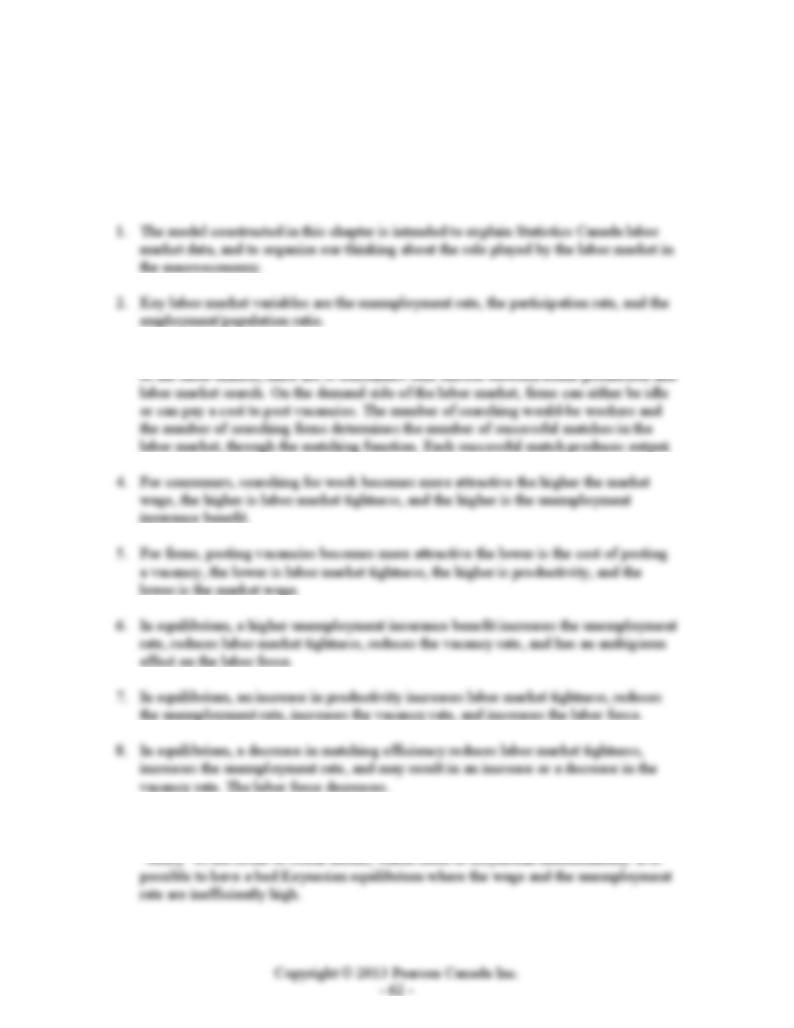
CHAPTER 6
Search and Unemployment
KEY IDEAS IN THIS CHAPTER
3. In the Diamond-Mortensen-Pissarides (DMP) labor search model, on the supply side
9. A form of Keynesian analysis is introduced. In the DMP model, bargaining between a
matched firm and worker determines the wage, but bargaining strength can be

Chapter 6: Search and Unemployment
1. The entire chapter is new.
TEACHING GOALS
Including a version of the DMP model in an intermediate macroeconomics text is a
novelty. Students should not have difficulty understanding the model, but they may need
some additional help, as the approach is somewhat different than what we use in standard
competitive equilibrium models, for example in Chapter 5. However, it helps to think of
the labor market in terms of demand and supply sides. Then, it is possible to use what a
student knows from Chapter 5 to teach them about the DMP model. Workers and firms
care about the wage in the same way they do in a competitive model, but now the market
“clears” in a different way. Workers care not only about the wage, but the employment
insurance benefit (because their job search may be unsuccessful) and labor market
tightness (which determines the chances of finding a job). Would-be employers care
about labor market tightness and the cost of posting a vacancy, as well as the market
wage. The matching function, which determines the number of successful matches as a
function of matching efficiency and the numbers of firms and consumers searching, is an
important concept. In this case, appeal to what students know about the production
function, as the matching function has the same properties. Then, one can appeal by
analogy to production so that the student understands how the matching process takes
place.
It is important first to understand the labor market data. The DMP model is very nice, as
the variables in the model match up almost exactly with the labor market data as
measured. The unemployed are those who chose to search but were unsuccessful, the
labor force is the number of people who actively searched and found a job (employed)
plus the number who actively searched and were unsuccessful (the unemployed), etc.
The experiments in the model – increase in the employment insurance benefit, increase in
productivity, decrease in matching efficiency – are all useful in understanding recent
economic events and less-recent ones. A problem in Canada is that Statistics Canada does
not collect vacancy data, so sometimes it might be useful to bring in U.S. data. The
Beveridge curve correlation is particularly helpful.
The “Keynesian DMP Model” comes from ideas in work by Roger Farmer. This is a nice
way to understand Keynesian ideas (for starters). With bargaining indeterminacy the
wage could be “stuck” at too high a level, with an unemployment rate that is too high. We
don’t deal with Keynesian economic policies in this chapter, leaving that for later
chapters.
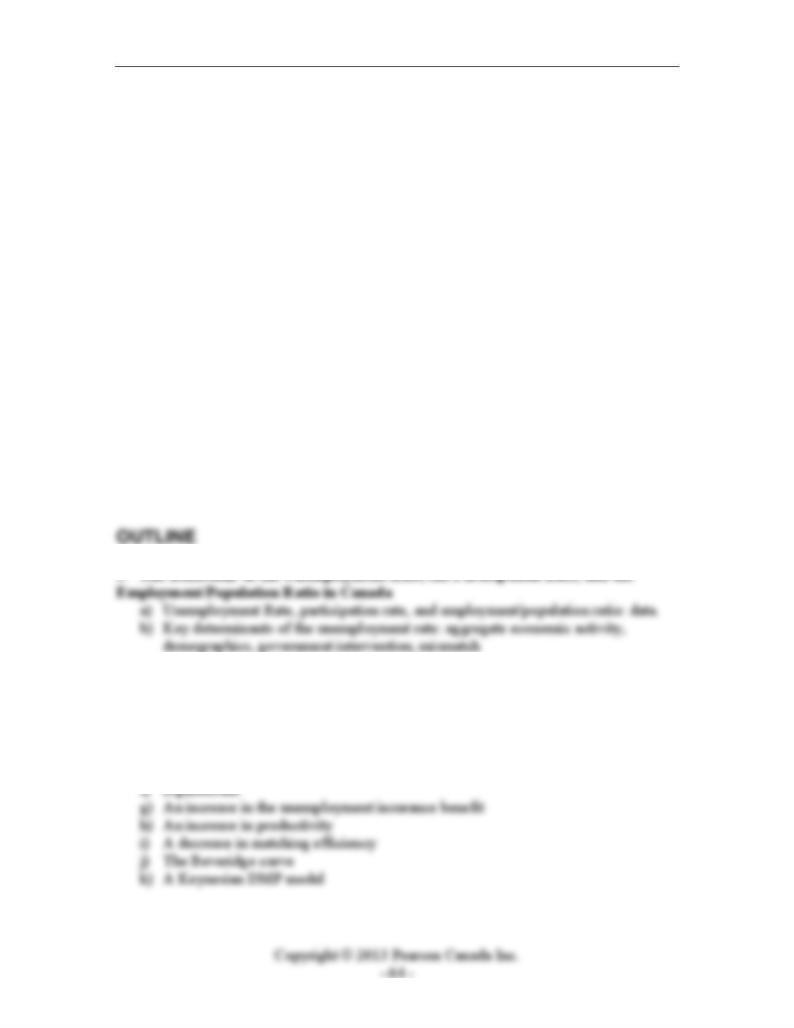
Instructor’s Manual for Macroeconomics, Fourth Canadian Edition
CLASSROOM DISCUSSION TOPICS
It should not be hard to get students talking about unemployment. Most of them should
know someone who has been unemployed, or they have read about unemployment as it
relates to the recent recession. However, students may not understand how
unemployment is actually defined, or how economists think about it. An important
feature of the DMP model is that there will be unemployment under any circumstances,
and students should understand that we cannot make unemployment go away, nor should
we want it to.
It will be helpful if students understand why a search-model approach is necessary to
understanding unemployment. Get them thinking about what an unemployed person is
actually doing, and what is motivating them. Unemployment is an economically
measurable activity, and we want to take a scientific approach to thinking about it.
Also, get the students to think about what motivates firms to search for workers to fill job
openings. Why is searching for workers costly? What difficulties does a firm face in
hiring workers? How does matching between firms and workers take place? Why is the
market for labor similar to, and different from, the market for a good or service?
Students should be encouraged to think about government intervention and how it matters
for labor market behavior. What will employment insurance do? How can the
government speed up or slow down the matching process in the labor market?
2. The Diamond-Mortensen-Pissarides Model of Search and Unemployment
a) Consumers
b) Firms
c) Matching
d) Optimization by Consumers
e) Optimization by Firms
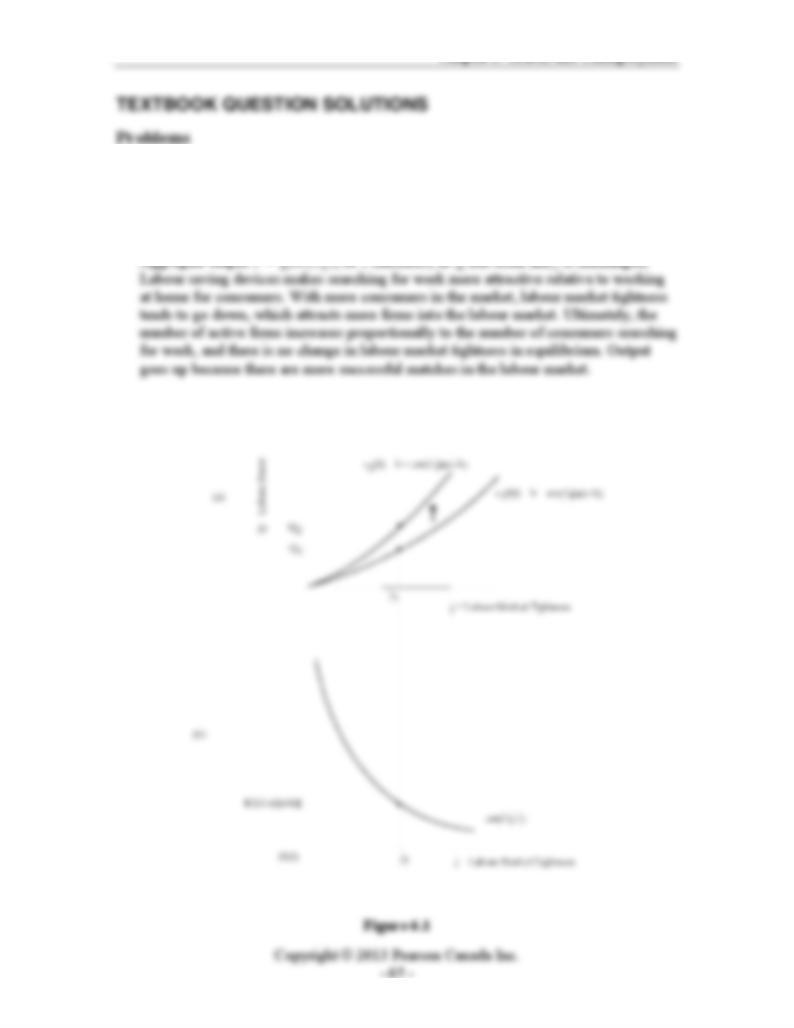
Chapter 6: Search and Unemployment
1. More labour-saving devices has the effect of reducing the payoff to working at home
for all consumers, which reduces v(Q) for each value of Q. As a result, the curve in
panel (a) of Figure 6.1 shifts up. In equilibrium, Q increases, but j remains
unchanged. The unemployment rate and the vacancy rate are unaffected, but the labor
force Q increases. Since j = A/Q, therefore the number of firms A increases.
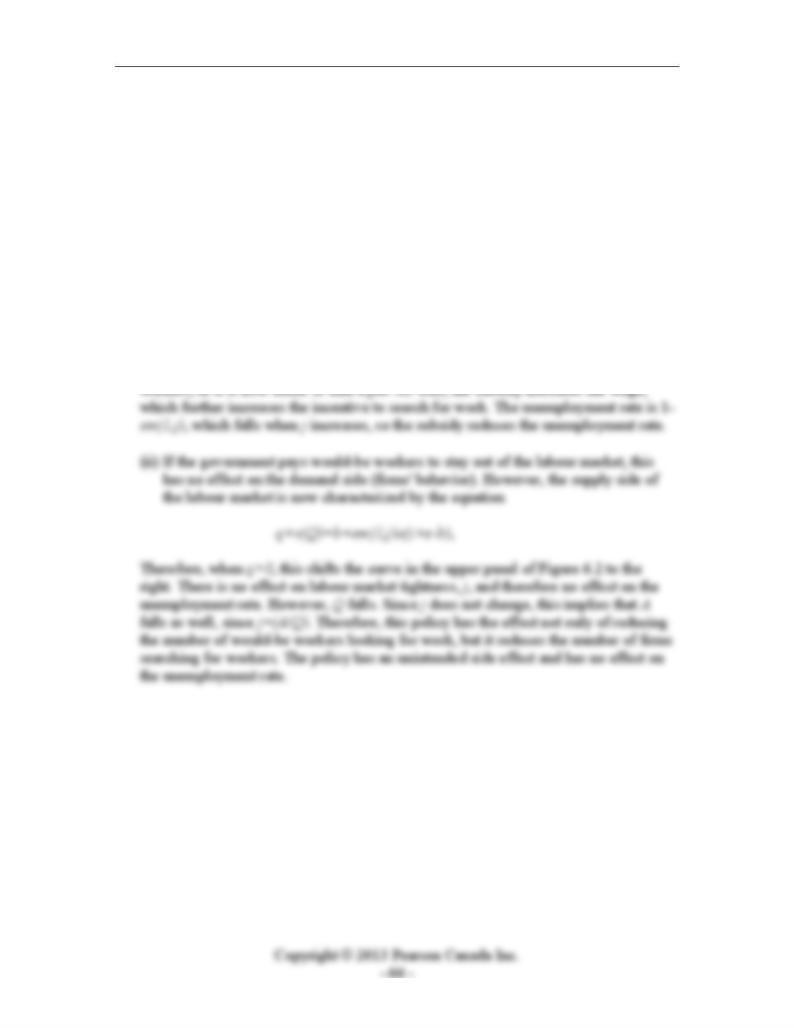
Instructor’s Manual for Macroeconomics, Fourth Canadian Edition
2. (i) With a subsidy s to hiring a worker, for a successful match, the surplus of the firm
is z+s-w, the surplus of the worker is w-b, total surplus is z+s-b, and the wage
(from Nash bargaining) is w=a(z+s)+(1-a)b. Then, on the supply side of the
labour market, the equation determining the curve in panel (a) of Figure 6.2 is
given by
v(Q)=b+em(1,j)a(z+s-b),
and on the demand side of the market, the equation determining j is
(k/((1-a)(z+s-b)))=em((1/j),1)
Then, in Figure 6.2, comparing the equilibrium when s=0 to one with s>0, the
subsidy acts to increase labour market tightness, j, and to increase the labour force, Q.
The subsidy acts to induce more firms to enter the labor market to search for workers,
which makes j=(A/Q) higher. This in turn acts to make search more attractive for
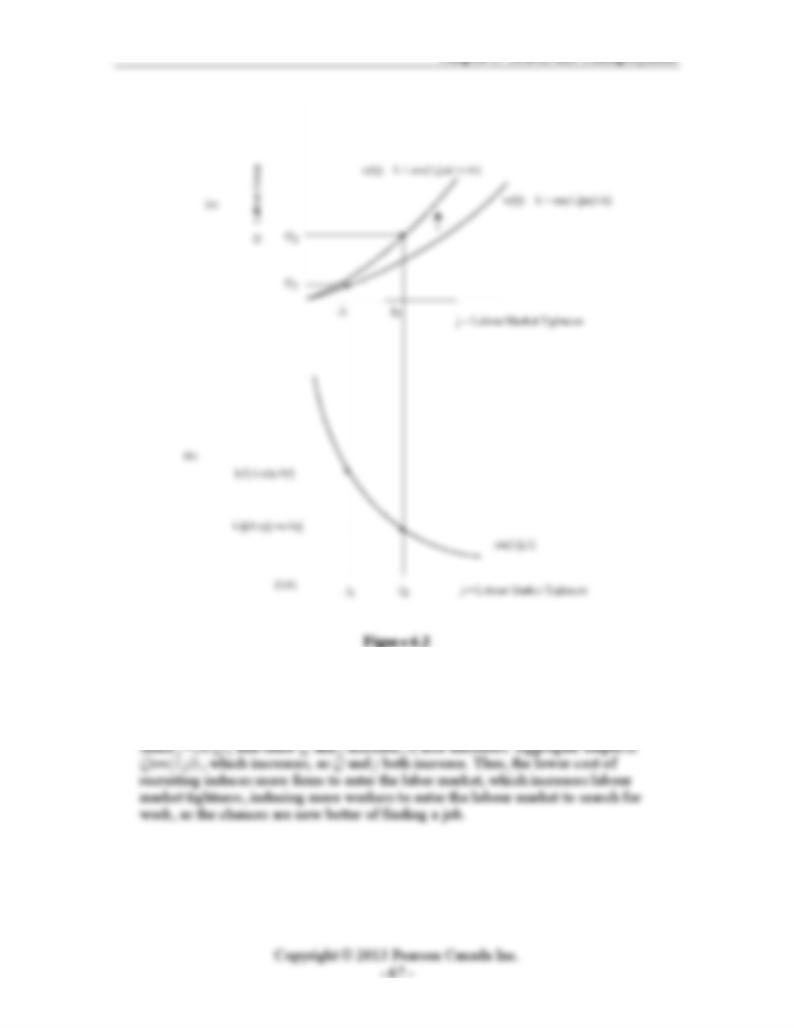
Chapter 6: Search and Unemployment
3. The lower recruiting cost, k, affects only the demand side of the labour market. In
Figure 6.3, labour market tightness increases from j to j, and the labor force
increases from Q to Q. The unemployment rate is 1-em(1,j), which decreases
because of the increase in j, and the vacancy rate is 1-em((1/j),1), which increases.
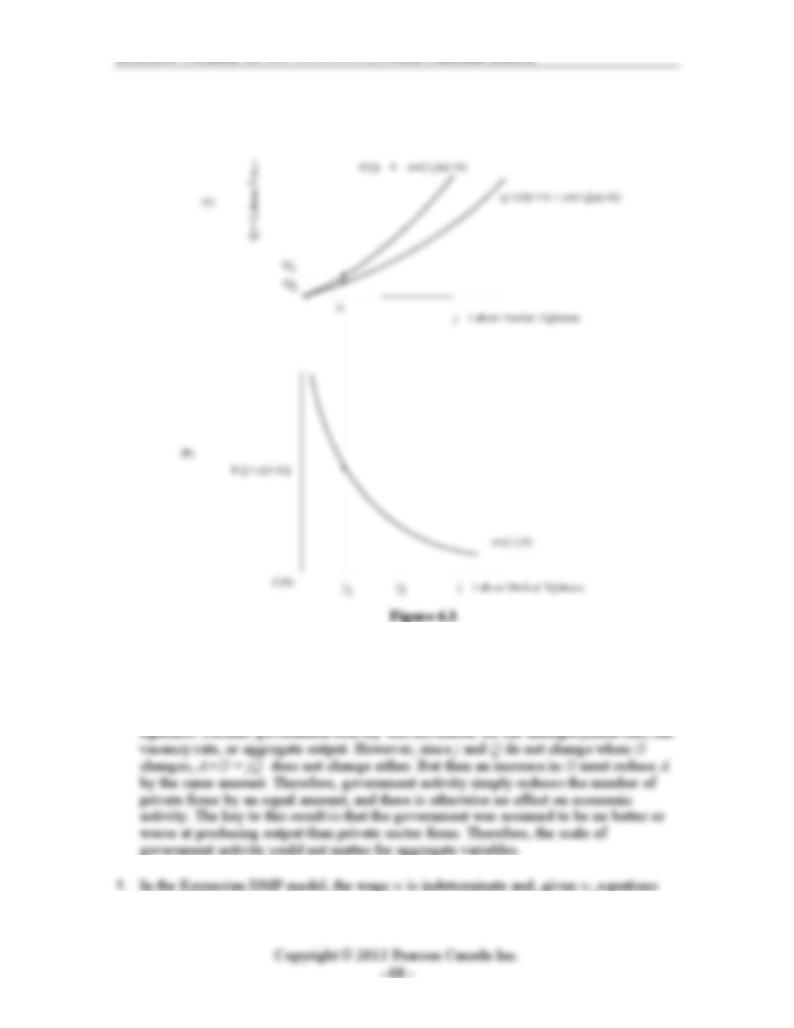
Instructor’s Manual for Macroeconomics, Fourth Canadian Edition
4. For this question, re-define labor market tightness as j = (A+G)/Q. Then, the diagram
we work with looks identical to Figure 6.10 in Chapter 6, and Q and j are determined
as in Figure 6.10. Note in particular that G is irrelevant for determining Q and j, so
government activity is irrelevant for the size of the labor force and labor market
(6.6) and (6.8) solve for Q and j, i.e.
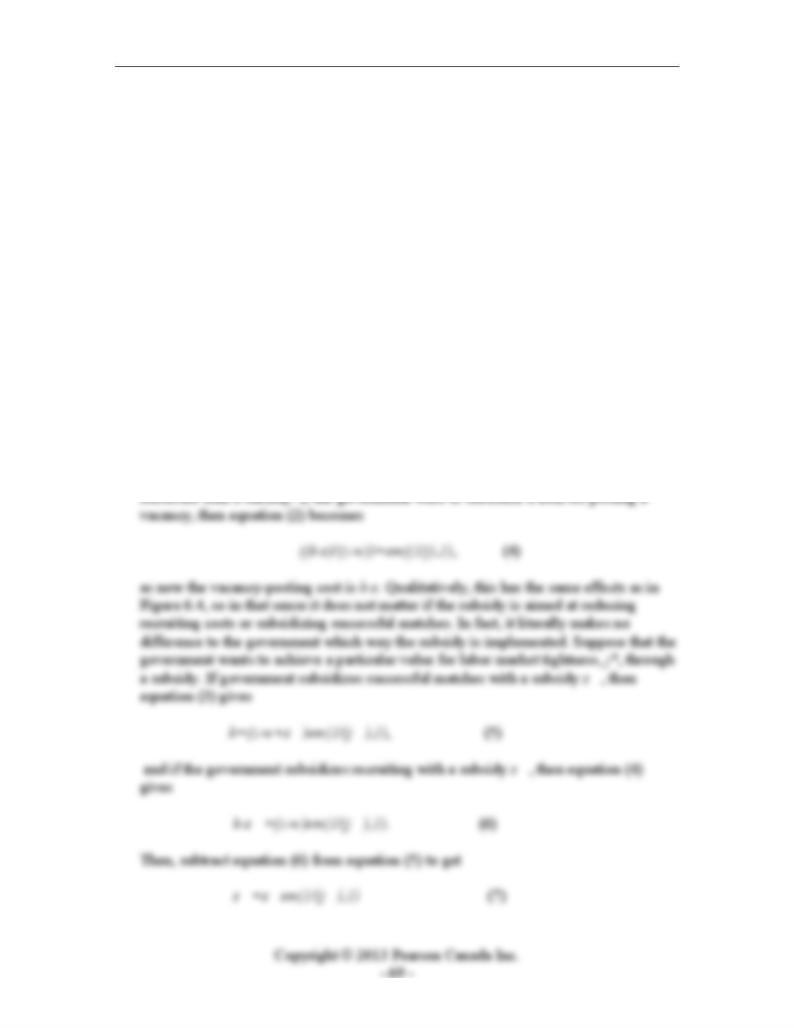
Chapter 6: Search and Unemployment
v(Q)=b+em(1,j)w, (1)
and
(k/(z-w))=em((1/j),1) (2)
Suppose that w is “too high” in equilibrium, which implies that Q and j are too low
relative to what is socially efficient. If the government were to subsidize successful
matches by paying s to a firm when a match occurs, then equation (2) becomes
(k/(z-w+s))=em((1/j),1), (3)
since the firm's surplus from a match (the firm's profit) is now z-w+s. In Figure 6.4,
this has the effect of increasing j and Q. As long as the government makes s
sufficiently large, it can correct the social inefficiency. The subsidy makes it more
attractive for firms to enter the labour market to search for workers, which in turn
attracts more would-be workers into the labour market as it is now easier to get a job.
The labor force increases, the unemployment rate decreases, the vacancy rate
increases, and GDP increases. In Keynesian models, there always exists some price
distortion - goods and/or labor are mispriced - and this type of inefficiency can be
corrected just as we would correct a standard type of inefficiency such as an
externality. Typically, we can correct a negative externality with a Pigouvian tax -
e.g. a tax on gasoline, as burning gas causes pollution. A positive externality can be
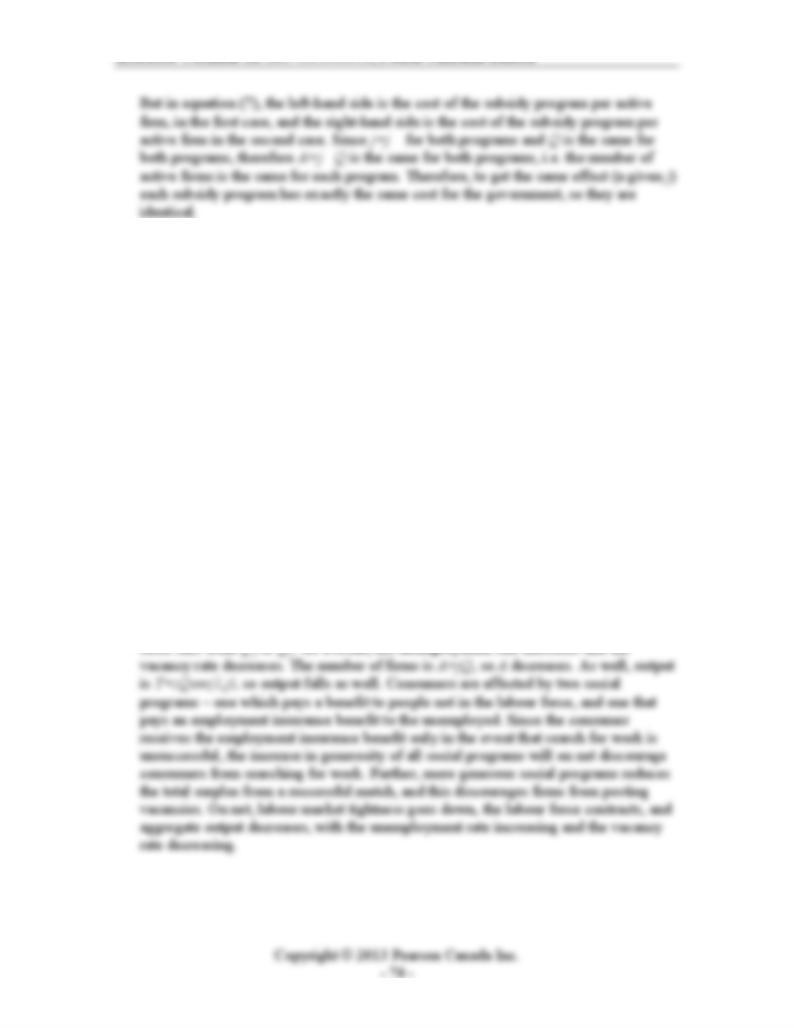
Instructor’s Manual for Macroeconomics, Fourth Canadian Edition
6. If all social welfare programs simultaneously become more generous, suppose that we
represent this as a payment p to each person not in the labor force, and an increase by
p in the employment insurance benefit. Then, the equation that summarizes behavior
on the supply side of the labour market becomes
v(Q) + p = b + p + em(1,j)a(z-b-p),
or, simplifying,
v(Q) = b + em(1,j)a(z-b-p).
As well, the equation summarizing demand-side behaviour in the labour market can be
written as
em(1/j,1) = k/(1-a)(z-b-p)
Therefore, in Figure 6.4, labour market tightness falls from j1 to j2, and the labour
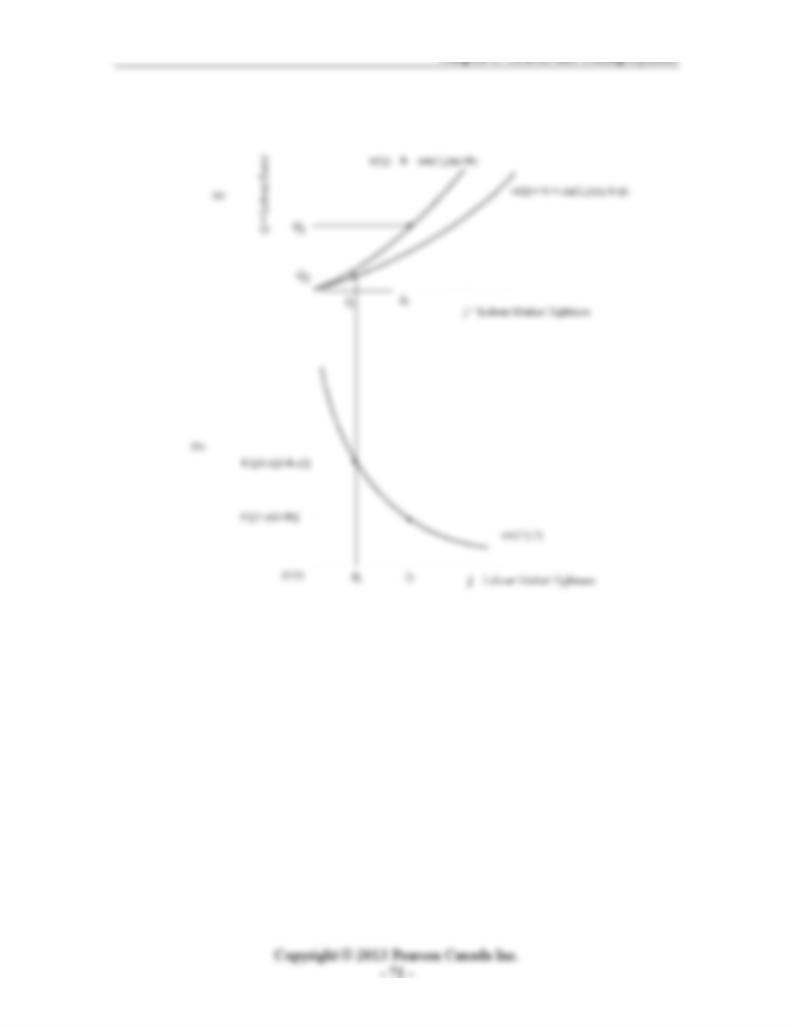
Chapter 6: Search and Unemployment